- 7 Top Flite Golf Clubs XL for Improved Performance - September 28, 2024
- Top Flite Golf Clubs: Top 5 Reasons to Choose Them - September 28, 2024
- Top 3 Golf Club Fitters for a Perfect Swing - September 28, 2024
You're about to discover that a golf club is a carefully crafted tool composed of three primary components – the head, shaft, and grip – designed to help you navigate the course with precision and control. The club head's loft markedly affects performance, with wedges ranging from 48 to 64 degrees and drivers from 7 to 12 degrees. Shafts, made from steel, titanium, or carbon fiber, impact accuracy and twisting. With various types of clubs, including woods, irons, hybrids, wedges, and putters, understanding their unique features and specifications is essential for peak performance – and as you explore further, you'll uncover the intricacies that make a golf club a powerful ally on the green.
Key Takeaways
- A golf club consists of three primary components: head, shaft, and grip, each playing a crucial role in the club's performance.
- The club head's loft significantly affects performance, with drivers having lofts of 7-12 degrees and wedges having lofts of 48-64 degrees.
- Golf clubs come in various types, including woods, irons, hybrids, wedges, and putters, each designed for specific shots and distances.
- The shaft's material, flex, and weight impact accuracy and twisting, with options including steel, titanium, and carbon fiber.
Understanding Golf Club Basics
You'll find that a golf club's overall performance relies on the harmonious integration of its three primary components: the head, shaft, and grip.
The club head, in particular, plays a vital role in determining the club's overall performance. Wedges, for instance, have varying degrees of loft, ranging from 48 to 64 degrees, which greatly impact their functionality. A club's loft is a key factor in its performance, with drivers typically having a loft between 7 to 12 degrees.
Understanding the intricacies of club heads and their corresponding lofts is important for selecting the right golf clubs for your game.
When choosing your clubs, it's important to take into account the specific shots and distances you need to cover. By grasping the fundamental components of golf clubs, you'll be better equipped to make informed decisions about your club selection, ultimately leading to improved performance on the course.
Club Types and Their Features
When it comes to maneuvering the golf course, understanding the distinct characteristics of each club type is essential, as each is specifically designed to tackle unique shots and distances.
You'll need to familiarize yourself with the four main categories: Woods, Irons, Hybrids, and Putters.
Here's a breakdown of each type:
- Woods: Used for long shots over 175 yards, with lofts ranging from 7 to 22 degrees.
- Irons: Used for shots under 200 yards, including numbered clubs (3-9) and a pitching wedge.
- Hybrids: Combine the design of a fairway wood head with the length of an iron shaft, providing a more forgiving option.
Within the wedge category, you'll find various types of wedges, including the pitching wedge, which is a staple in most golf sets.
The club face of each wedge is angled to produce a specific trajectory and spin, making them essential for maneuvering tricky terrain.
Construction and Design Elements
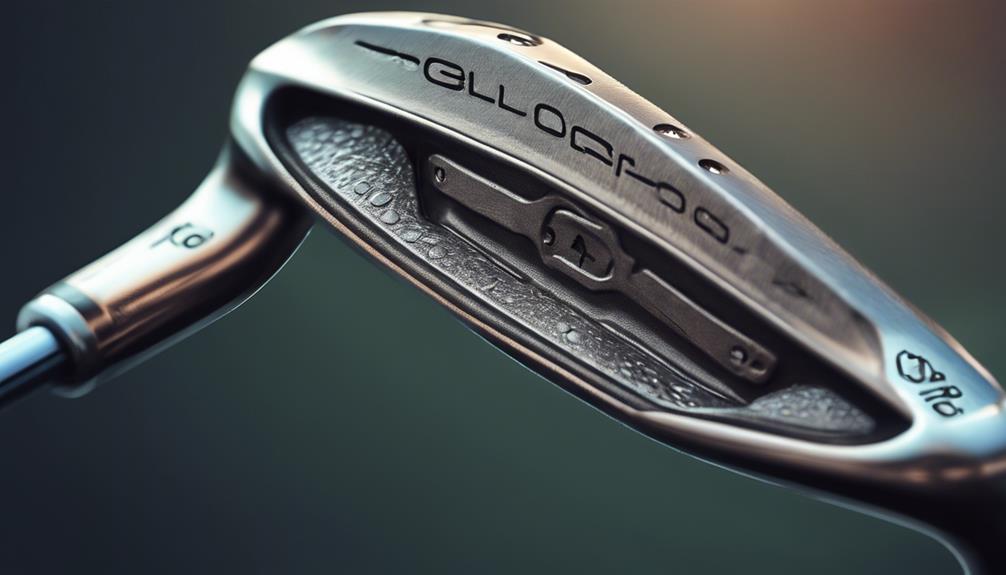
Golf clubs are precision-engineered instruments, comprising three primary components – the head, shaft, and grip – each playing a critical role in delivering a consistent and accurate swing. As you hold a modern club, you'll notice the club head, which strikes the ball, is constructed from advanced materials designed for peak performance. The shaft, connecting the head to the grip, is typically made from steel, titanium, or carbon fiber, enhancing performance through improved accuracy and reduced twisting during swings.
| Component | Material | Function |
|---|---|---|
| Club Head | Advanced materials | Strikes the ball |
| Shaft | Steel, titanium, or carbon fiber | Connects head to grip |
| Grip | Leather or rubber | Provides control and comfort |
The hosel connects the club head to the shaft, affecting balance and feel, while the ferrule, a decorative ring above the hosel, secures the shaft to the club head. Your grip, whether it's leather or rubber, tapers in thickness but adheres to rules that prevent waisting or bulging, ensuring a consistent hold. As you master your swing, understanding these construction and design elements will help you appreciate the precision engineering that goes into creating a high-performance golf club.
Shaft Specifications and Performance
With precise engineering, shafts are crafted to optimize performance, boasting varying specifications that greatly impact the club's overall dynamics and your ability to deliver a consistent swing.
When selecting a shaft, you'll encounter a range of options that can notably influence your game.
Here are four key shaft specifications to take into account:
- Flex: Shafts come in various flex options, including Lady/Womens, Soft Regular, Regular, Stiff, and Tour Stiff, which affect the club's power and accuracy during swings.
- Weight: Shaft weights vary from 45 to 150 grams, influencing the overall feel and swing dynamics of the club.
- Torque management: Varying shaft thickness helps reduce club head twisting, enhancing accuracy during shots.
Understanding these shaft specifications is essential for mastering your swing.
By selecting a shaft that suits your swing style, you can optimize energy transfer, reduce twisting, and achieve more consistent shots.
With the right shaft, you'll be well on your way to improving your game.
Evolution of Golf Equipment Regulations
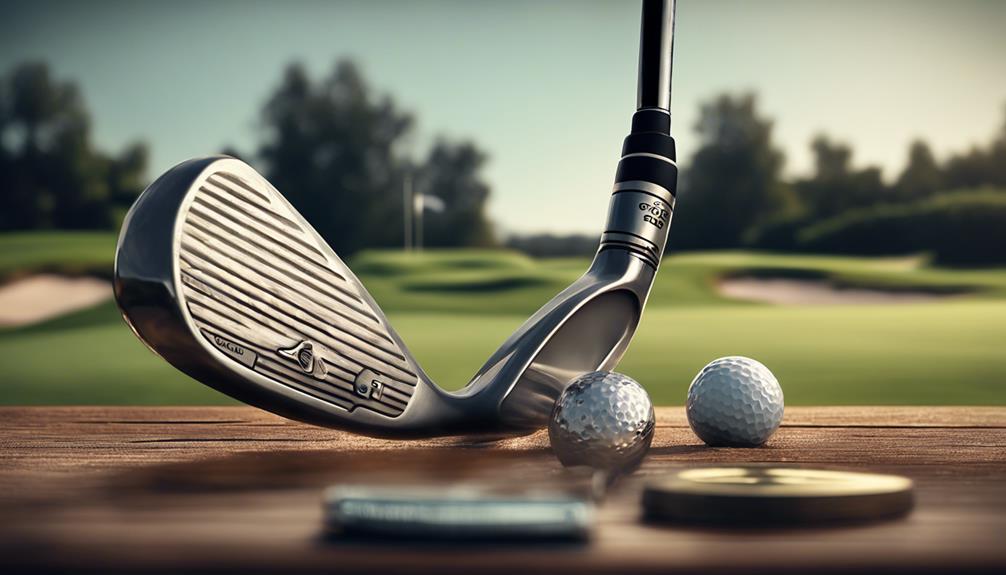
As you've fine-tuned your swing with the right shaft, you're likely curious about the evolution of golf equipment regulations that have shaped the game into what it's today.
The introduction of steel club shafts in 1910 marked a significant shift, offering enhanced durability and performance compared to wooden shafts.
In 1924, the USGA lifted its ban on steel shafts, paving the way for innovation in golf club design. Later, the USGA established a 460cc volume limit on driver club heads, allowing for non-traditional shapes while maintaining performance standards.
Advances in technology led to the implementation of a COR limit of .830 for trampoline effect in woods, effective January 1, 2008, to guarantee fair play.
In addition, regulations were updated to require professionals to use compliant wedges without square grooves by January 1, 2010, reflecting ongoing adjustments to maintain standards in the sport.
These regulations have played an essential role in shaping the modern golf club, with composite materials and clever design allowing for improved performance while adhering to the rules of golf.
As you continue to master your game, understanding these regulations will help you appreciate the nuances of the game.
Historical Context and Resources
Nearly six centuries of evolution have shaped the modern golf club, yielding significant advancements in design, materials, and technology. As you explore the world of golf equipment, it's crucial to understand the historical context that has led to the sophisticated clubs you use today.
Here are some key points to reflect on:
- Material advancements: From wooden shafts to modern materials like steel and carbon fiber, golf clubs have undergone a significant transformation.
- Regulatory developments: Historical rulings, such as the USGA's lawsuit against square grooves in Ping Eye2 irons, have shaped current manufacturing practices and equipment compliance.
- Specialized clubs: The introduction of various club types, such as the pitching wedge and gap wedge, reflects the growing need for specialized clubs to address specific golfing scenarios.
Club Sets and Customization Options
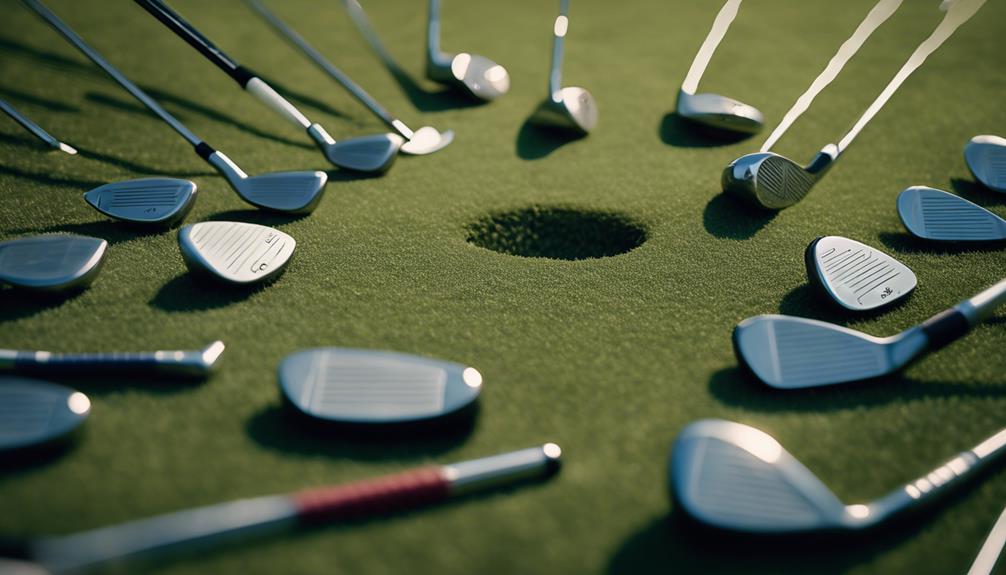
Your golf bag is a critical component of your game, and understanding the composition of a standard club set, as well as the various customization options available, is essential to optimizing your performance on the course.
A standard set of golf clubs consists of up to 14 clubs, including woods, hybrids, irons, wedges, and putters. You can customize your set to suit your individual preferences, mixing and matching different club types and specifications to create the perfect combination.
The loft of each club considerably affects its performance, so you can choose from various lofts to optimize distance and trajectory for specific shots. Additionally, you can select from different shaft materials, such as steel, titanium, or carbon fiber, and flex categories, including L/W, A/I, R, S, and X, to enhance your game based on your swing speed and style.
The Role of Loft in Club Performance
When it comes to optimizing your club set, understanding the role of loft in club performance is essential, as it directly impacts the trajectory and distance of your shots. Loft, or the angle of the clubface, affects how high the ball will launch and its distance.
Here are some key points to evaluate:
- Loft ranges vary by club type: Drivers have the lowest loft (7-12 degrees), while wedges have higher lofts (up to 64 degrees).
- Specific lofts for specific shots: A pitching wedge usually has a loft of 44-48 degrees, a sand wedge 54-58 degrees, and an approach wedge falls in between.
- Loft gaps and filling them: The difference in loft between clubs can create gaps in distance, which is why clubs like the A-wedge (gap wedge) were developed.
Golf Club Selection and Psychology
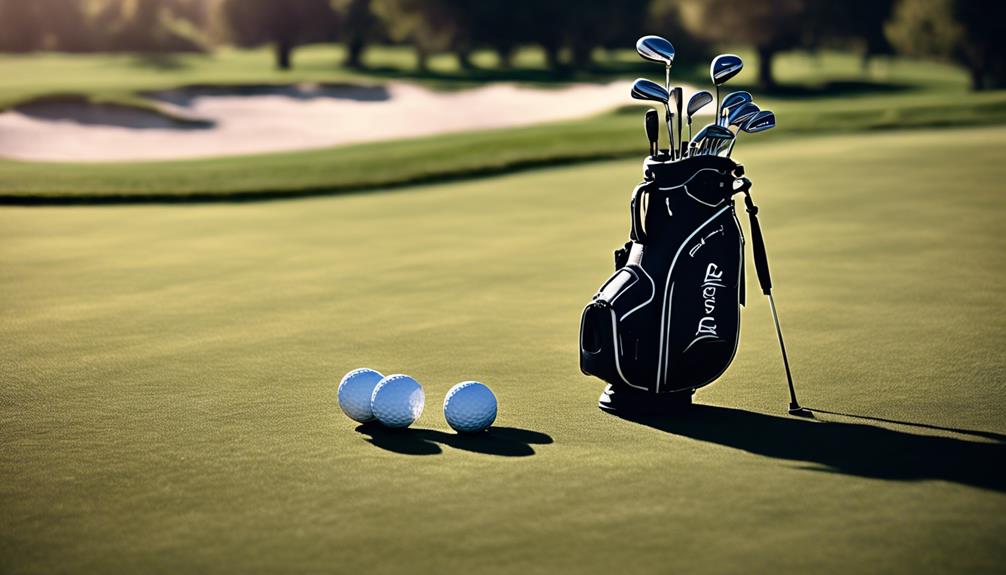
With a diverse set of clubs at your disposal, selecting the right one for a particular shot can be a game-changer. It's essential to understand the psychology behind golf club selection to make informed decisions on the course. Your club selection can greatly impact your performance, especially when it comes to executing shots that require precision and accuracy. For instance, choosing the right wedge, such as a pitching wedge or sand wedge, can make all the difference in maneuvering tricky lies and hazards.
When making your selection, consider your individual needs, preferences, and skill levels. Don't rely on a single source of advice; instead, gather insights from different sources, including instructors, online resources, and fellow golfers. This will help you develop a personalized approach to golf club selection, tailored to your unique strengths and weaknesses.
Wedges and Putters in Golf
As you navigate the nuances of golf club selection, it's time to focus on the precision instruments that can make or break your short game: wedges and putters.
Wedges are specialty irons designed for shorter, more precise shots, with lofts increasing in increments of 4 degrees. Here are the types of wedges you'll want to familiarize yourself with:
- Pitching wedge: For shots requiring a higher trajectory and more spin.
- A-wedge (gap wedge): Fills the gap in loft between the pitching wedge and sand wedge, allowing for better control of shot distance and trajectory.
- Sand wedge: Specifically designed for bunker shots, with a higher loft to escape sand traps.
Putters, on the other hand, are used primarily on the green to roll the ball into the hole. With various styles like mallet, blade, and belly, each is designed to provide unique benefits based on player preference and putting technique.
Golf Club Maintenance and Care
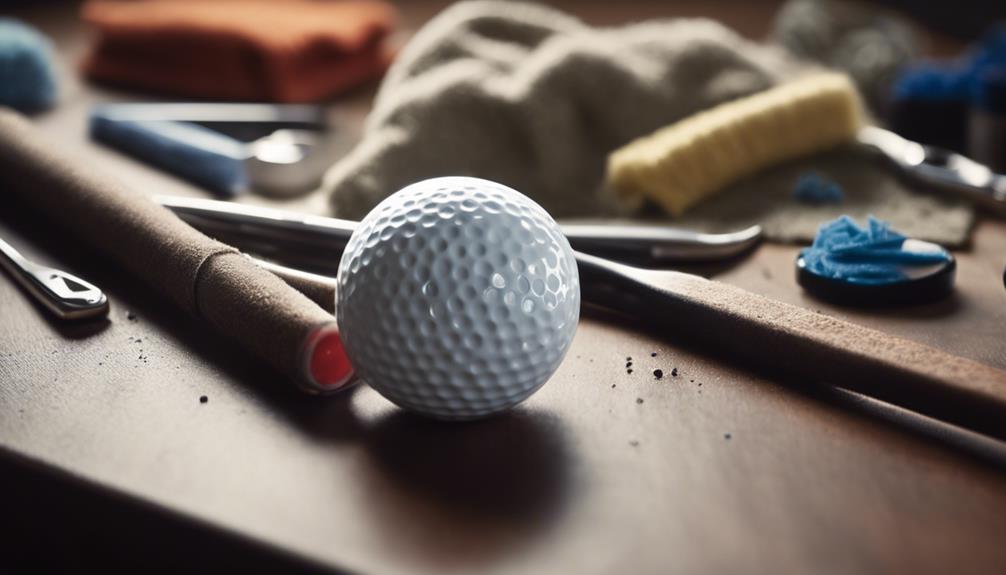
You take an essential step in preserving your golf game's integrity by regularly maintaining and caring for your golf clubs.
After each round, clean your golf clubs using a soft brush and warm, soapy water to remove dirt and grass, which helps maintain grip and performance. Inspect club heads for signs of wear and tear, such as scratches or dents, as these can affect the club's performance and accuracy. Proper storage is also vital; store your golf clubs in a protective bag or case to prevent damage from impacts and exposure to extreme temperatures or humidity.
Additionally, periodically check and replace grips if they become worn or slick, as good grip condition is essential for control during swings. You should also schedule professional re-shafting or loft and lie adjustments as needed to guarantee your clubs are properly fitted for your swing and playing style.
Frequently Asked Questions
What Does the a Golf Club Stand For?
You might wonder what the term "golf club" stands for; it doesn't represent an acronym, but rather encompasses various aspects, including golf club types, materials, history, and fitting, which all contribute to a rich golfing experience.
What Is Called a Golf Club?
You're wondering what's called a golf club? It's the entire set of clubs, including woods, irons, hybrids, and putters, made from materials like steel, titanium, or graphite, with a rich history and iconic brands like Callaway and TaylorMade.
What Is a Club in Golf Game?
You wield a club in golf like a conductor's baton, orchestrating shots with precision. A club is one of 14 tools in your bag, varying in type (woods, irons, hybrids, putters), materials, and fitting to suit your swing, requiring regular maintenance for peak performance.
How Many Clubs Are There in Golf?
You'll find over 20 golf club types, varying in length, materials, and design, with options for custom club fitting to suit your swing; however, you're limited to carrying 14 clubs in your bag during a game.
Conclusion
As you stand on the green, golf club in hand, the weight of history and innovation settles in.
Like a trusted companion, your club has been crafted to precision, its design and construction honed to deliver peak performance.
With every swing, you're connected to the greats who've come before, their triumphs and struggles etched into the very metal and graphite that guides the ball toward its destiny.
In this sacred dance, club meets ball, and magic unfolds.




